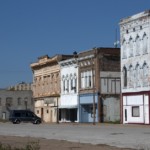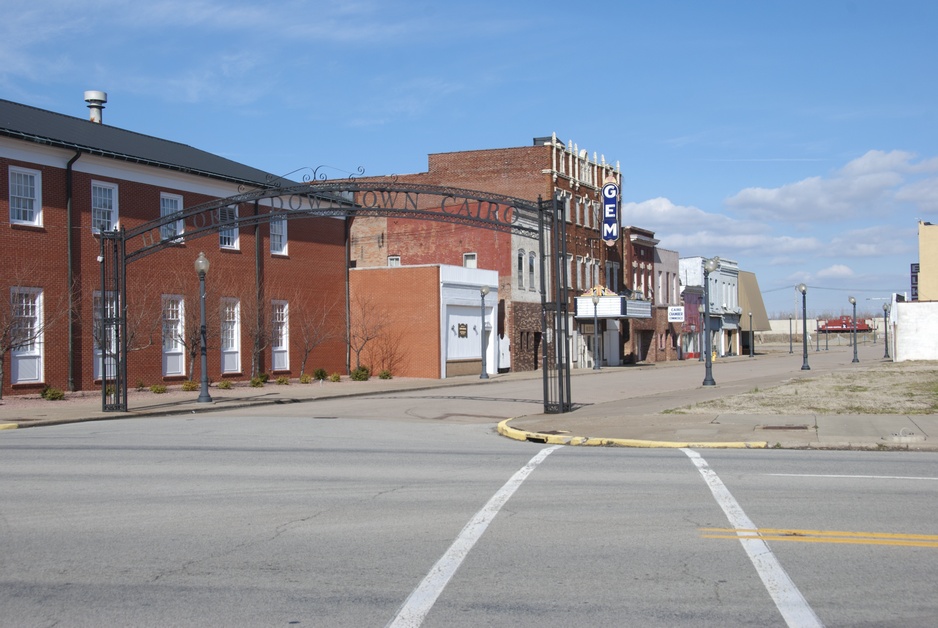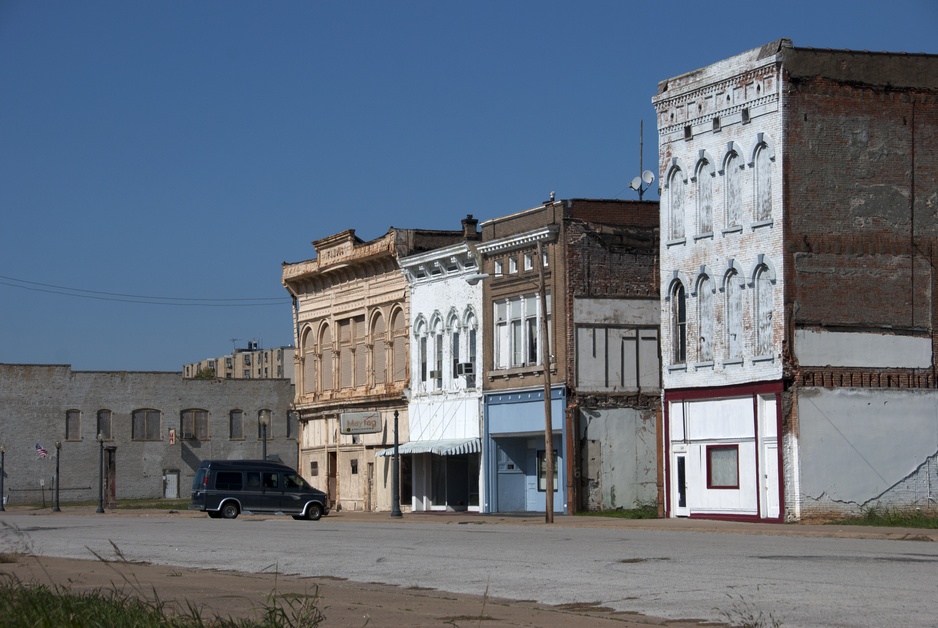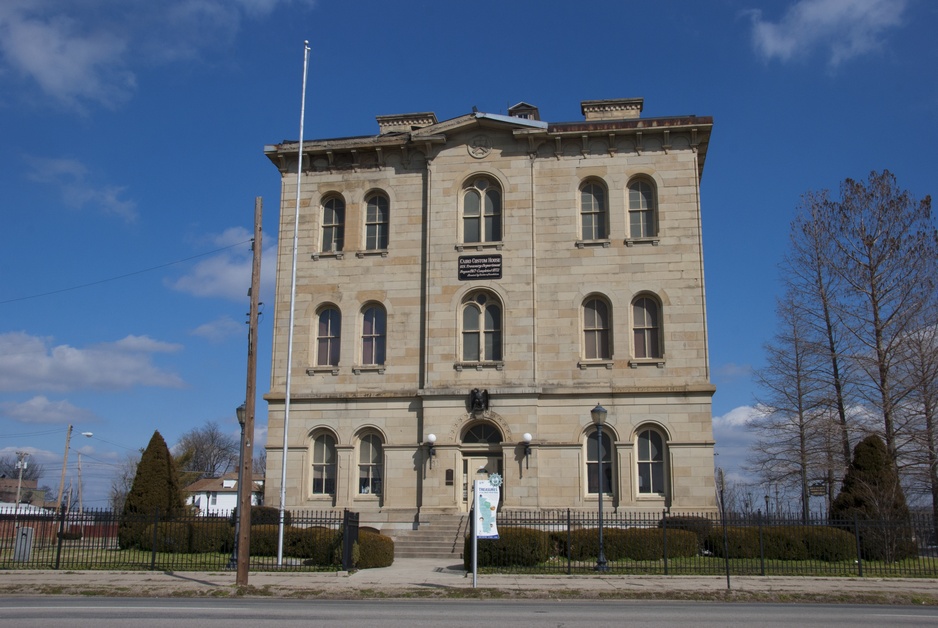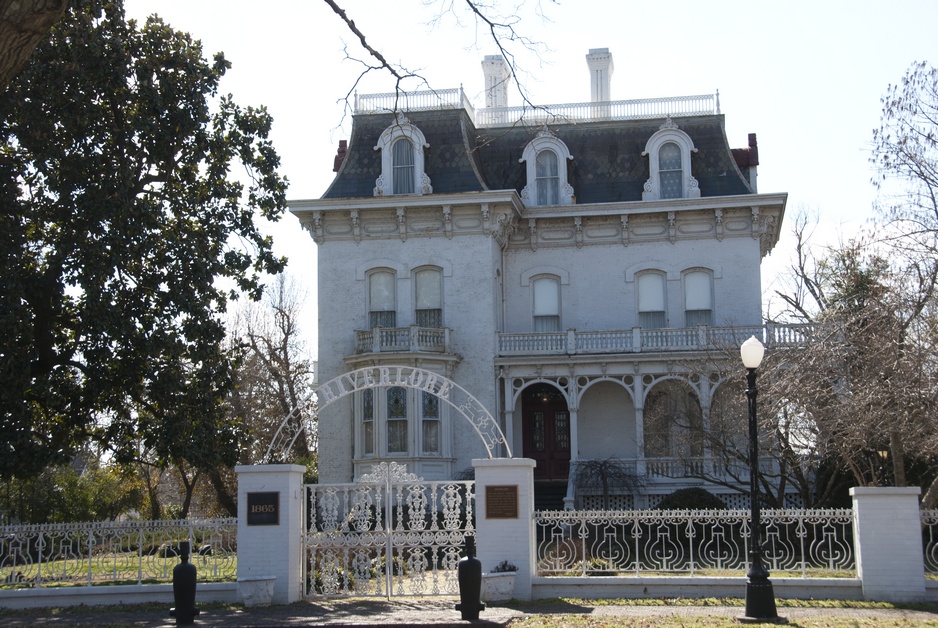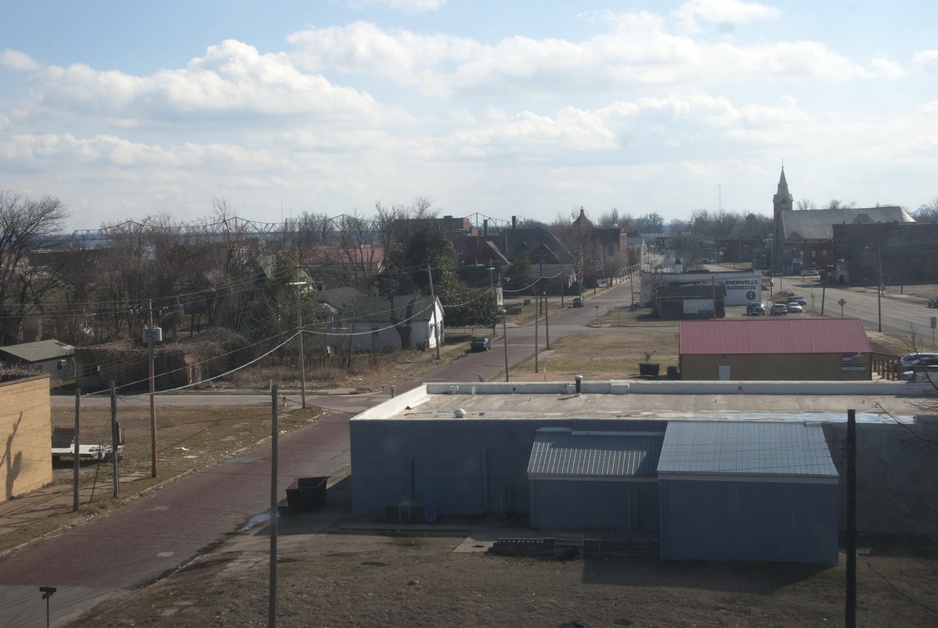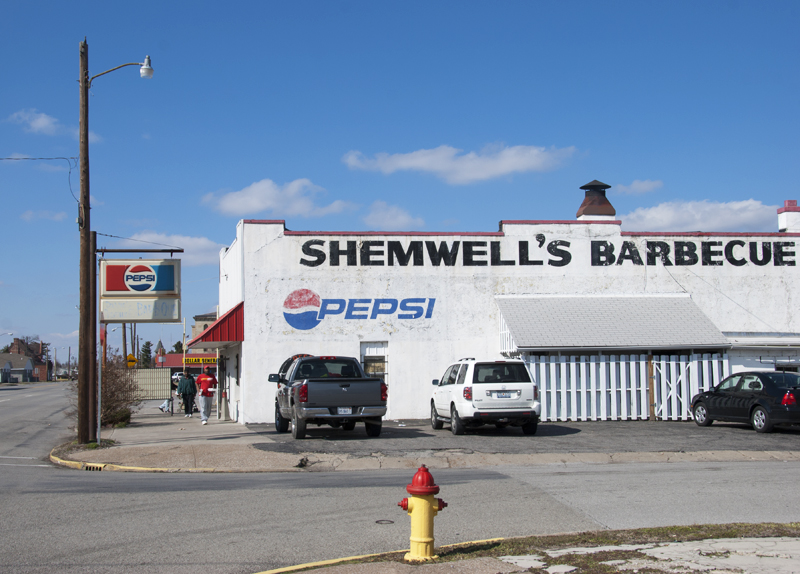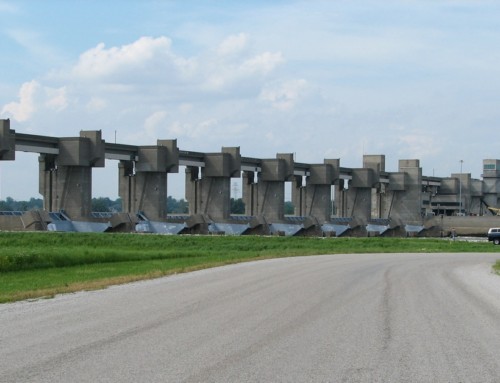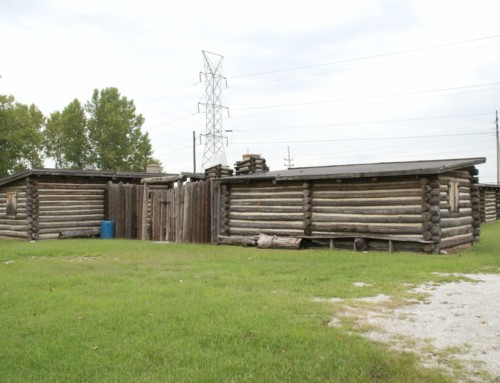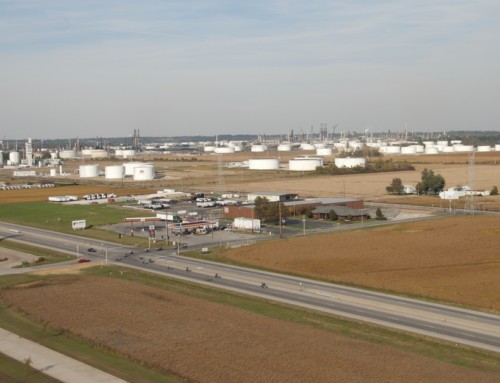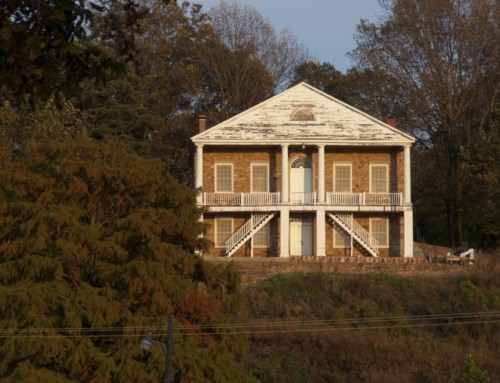Introduction
Once a bustling port at the confluence of two of the biggest rivers in the US, Cairo (pronounced CARE-o) today is a shell of its former self. The reasons for its shocking decline aren’t too hard to figure out.
History
The confluence of the Ohio and Mississippi Rivers was too important of a crossroads to ignore. Before the area was cleared, the land was a vast, bottomland forest dominated by cottonwoods, sycamores, maples, and boxwoods; wild game was plentiful. The forest was barely 300 feet above sea level, so it flooded often, which made it a difficult location to build on. Both the French and British attempted to establish a presence and both failed.
Late in the 18th century, General George Rogers Clark built Fort Jefferson on the east bank of the Mississippi River about five miles downstream of the confluence, where the land didn’t flood as often. The resident Chickasaw Indians weren’t too happy about the influx of new people, so they attacked the fort. After six days, the Chickasaws relented, then most of the new settlers gave up and left, too, like Captain James Piggott who moved upriver and founded what later became East St. Louis.
When Enoch Swarthouse passed by in 1809, hardly anyone lived at the confluence. He saw a hut on stilts, a “water-logged canoe” and a few stakes driven in the ground to tie up to.
The motivation to establish a city at the confluence increased as steamboat travel grew. Just four days after Henry Shreve’s steamboat, the Washington, completed a 25-day round trip from Louisville to New Orleans in 1817, William and Thompson Bird bought 318 acres at the southern end of the peninsula. Around the same time, John Gleaves Comegys bought another 1,800 acres in the area.
Comegys, unlike the Birds, had grand plans: he convinced the Illinois Territorial Legislature to pass a bill incorporating the City of Cairo and a bank in 1818. He apparently chose the name because he thought the area resembled the Nile Delta. He promoted the heck out of his plan but died before he could develop anything. The land reverted to the control of the US government just as Illinois became a state.
The Birds didn’t build anything until 1828 when they brought their enslaved laborers across the river and built a tavern and a store. When Alexander Phillip Maximilian, Prince of Wied-Neuwied, passed by in 1832, there was just that store and tavern, plus a few houses at a place known simply as “Mouth of the Ohio.”
Judge Sidney Breese tried to resurrect the Comegys plan, pulling together a group of investors who hoped to build a railroad to Cairo. Darius Blake Holbrook emerged as the primary marketer and ran much of the day-to-day show. In 1835, the investors bought all of the land at Cairo except for the Bird’s plots. Two years later, the Illinois legislature approved the incorporation the Cairo City and Canal Company. With Holbrook taking the lead, the group managed to get financing from London’s John Wright & Company. The financiers sent representatives to look at the site and were impressed. In their December 1838 report, they wrote:
…the whole peninsula is covered with a growth of forest trees many of which are 3 to 8 feet in diameter: The cottonwood, sycamore, mulberry, maple and boxwood, abound over the surface…The railroad now constructing by the State of Illinois is already at this point; the route is cleared of the timber and the depot is laid out on the Ohio river front…There is not in any quarter of the globe a situation so commanding and replete with every kind of produce and material to promote the prosperity of the merchant, the skill of the mechanic, and the growth of a great city.
The company ran elaborate ads in London papers and attracted a lot of investors. The company used some of the money to build a small v-shaped levee to protect the town from the big rivers, and a few businesses moved in: a planing mill, an iron mill, sawmills, a brickyard, and shipyards. Dozens of homes were built, and the town quickly attracted hundreds of new residents.
Holbrook had a hard time convincing those new residents to stick around, however. The conditions were often unpleasant—summer heat bred intolerable numbers of mosquitoes and flies, while winter meant plodding through muddy streets. Besides that, though, Holbrook owned everything, so new residents were forced to lease property from him. This bred discontent. One resident, Moses Harrell, complained that:
…even personal liberty and freedom of thought were brought in direct antagonism to this singular undertaking. … At no price, in no shape or form, could a resident of this city . . . become a freeholder. He could not purchase, he could not lease … a single foot of ground within the proposed city … he lived in it only during the pleasure of this ‘Lord of the manor’.
The chickens came home to roost in 1840. The State of Illinois had quit building the railroad in 1837, but Cairo survived, at least until the London bondholders went bankrupt in 1840. The Cairo bank failed quickly after that, and within a few months businesses closed and residents got the hell out. A flood in 1842 washed away a few abandoned buildings and made the rest look even worse. When writer Charles Dickens passed by the remnants of Cairo on April 9, 1842, he wasn’t impressed.
At the junction of the two rivers, on ground so flat and low and marshy, that at certain seasons of the year it is inundated to the house-tops, lies a breeding-place of fever, ague, and death; vaunted in England as a mine of Golden Hope, and speculated in, on the faith of monstrous representations, to many people’s ruin. A dismal swamp, on which the half-built houses rot away: cleared here and there for the space of a few yards; and teeming, then, with rank unwholesome vegetation, in whose baleful shade the wretched wanderers who are tempted hither, droop, and die, and lay their bones; the hateful Mississippi circling and eddying before it, and turning off upon its southern course a slimy monster hideous to behold; a hotbed of disease, an ugly sepulchre, a grave uncheered by any gleam of promise: a place without one single quality, in earth or air or water, to commend it: such is this dismal Cairo.
- Random Fact: Cairo left such a lasting impression on Dickens that he used the town as inspiration in his novel Martin Chuzzlewit. In that book, the title character goes to a place called Eden that was a “hideous swamp” that was “choked with slime and matted growth,” a destitute and depressing place run by the corrupt Eden Land Corporation.
After the crash of 1840, a few dozen people stuck around to run taverns and supply passing boats; those folks did okay. Miles Gilbert arrived in 1843 to oversee the interests of the Cairo City and Canal Company and built a third levee that connected with the other two, so the city was finally protected all around. Those levees were even high enough to protect the small city during the Great Flood of 1844.
By 1848, the city had about a hundred residents and steamboat landings were picking up. Along the Ohio levee, the Cairo, Louisville, and Ellen Kirkman, did a brisk business as wharfboats, selling groceries to passing steamers, and offering temporary storage and lodging. Cairo also did a pretty good gambling business, although this didn’t please everyone.
Around 1851, another effort to develop Cairo gathered momentum. Plans for a cross-state railroad were finally gaining steam with the incorporation of the Illinois Central Railroad; Cairo was chosen as one terminus. The trustee for the Cairo City Property Trust, S. Staats Taylor, traveled west from New York City to Cairo to manage the company’s investment. Once there, he went around evicting people from the land that the company had just bought. The company took its time selling property, so the riverfronts filled with floating houses and businesses until lots finally became available for purchase at the end of 1853.
The railroad construction attracted a lot of transient workers, which just added to the town’s already rough reputation. The riverfront boomed with taverns and brothels that catered mostly to construction workers and steamboat passengers.
The first train finally left from Cairo on November 22, 1854; the trip to East St. Louis took twelve hours. That same year, Cairo counted 3,798 steamboat arrivals, or 700 more than St. Louis. The village incorporated in 1855 and one of their first official acts was to ban steamboats from dumping sick and dying passengers in the city, which they had been doing for a long time.
By 1856, the city’s population had reached a thousand again but not everyone who arrived was welcome. Because of the city’s location as the first slice of free territory, it was attracting a growing population of free blacks and runaway slaves. In 1856, one of the city’s papers, the Weekly Times and Delta, wrote that the city is “almost entirely overrun with free niggers.” A few months later, white mobs went on a four-day rampage kidnapping free blacks and trying to sell them into slavery in Missouri. When that effort died down, they drove free blacks out of town at gunpoint.
Runaway slaves also found little safety in Cairo. One enslaved man who escaped recalled that “…though Cairo was free in name, it was one of the most active depots of the Negro catchers [who] made quite a large income by returning [slaves] to their masters under the sanction of the Fugitive Slave Law.”
The city voted overwhelmingly for Stephen Douglas in the 1860 election (347 votes to just 76 for Lincoln) but became a Union stronghold almost as soon as the Civil War began. Just one week after the Confederacy attacked Fort Sumter, Secretary of War Simon Cameron ordered soldiers to Cairo to protect the strategic location.
Within a few weeks, 5,000 troops occupied the makeshift Camp Defiance at the confluence, backed up by three packet boats that had been retrofitted with guns. In September 1861, Ulysses S. Grant set up headquarters in the city and a short time later began campaigns into Confederate territory.
Shipyards at nearby Mound City and (and in St. Louis) built iron clad boats and other warships. Thousands of blacks fleeing slavery sought refuge in Cairo, living temporarily in a “contraband” camp; many chose to settle in Cairo after the war ended.
Cairo was a key base for Union forces as they fought to gain control of the Mississippi River. Residents of the city probably didn’t mind all that much. In fact, they did quite well, profiting handsomely by selling supplies to the Army and its troops. Still, the war interrupted the flow of cargo on the river and the resulting shift to railroads would prove to be permanent.
After the Civil War, the city boomed: its population nearly tripled from 2,188 in 1860 to 6,267 in 1870, even after a series of fires in 1865. Several new factories opened, including a brass foundry, a steam engine plant, a vinegar factory, a boiler works, and machine shops. Five newspapers kept residents informed (more or less), including one German-language paper. Cairo built its first sewer system in 1866 and even installed some wooden sidewalks. A yellow fever epidemic in 1878 scared a couple thousand residents out of the city, ultimately killing 41 people.
For a few years after the Civil War, riverboats continued to play an important role in Cairo’s economy. The nature of the river traffic changed, though. There were some log rafts coming from the northern forests, but most boats ran routes that were local, between Paducah and Memphis, for instance, rather than to New Orleans or St. Louis. Some boats also ferried rail cars across the rivers, at least until 1889 when the Illinois Central Bridge opened. When river traffic finally began to wane around 1880, the railroads kept a lot of folks employed. By the end of the 19th century, Cairo was connected to seven separate railroads.
Cairo continued to draw new residents at the end of the 19th century and into the early part of the 20th century. The city’s population peaked in 1920 at 15,000 people. Cairo was a busy regional hub for shopping and entertainment. During Prohibition, Cairo was an easy place to get a drink. In the 1930s, the main industries included warehousing, transshipping (between railroads and the river), lumber milling, and cotton seed processing. There were also factories that turned out egg cases, overalls, and ice cream. Farms in the area grew corn, clover, alfalfa, wheat, vegetables, watermelons, and tobacco, some of which was shipped through Cairo. But the city’s future wasn’t as solid as it seemed.
Cairo was built on a vigilant and virulent foundation of racial oppression. Most of the African American population—about a third of the city in 1940—lived in a segregated neighborhood in the center of town. Cairo had eleven churches for white residents and eleven churches for African Americans. There were four grade schools for whites and three for African Americans, and one junior high and high school for each group.
As the fight against segregation and Jim Crow grew in neighboring states, life changed very little in Cairo. Whites and blacks lived in different social worlds, not by choice but through the force of law and social pressure. Restaurant seating was reserved for white residents only; if you were black, you had to go to a back door or window and get food to go. Blacks were banned from the public library and the swimming pool. The only hospital in town refused to treat black residents. And just so there was no confusion about what group you belonged to, the city directory had an asterisk next to the name of every African American resident.
Periodic outbursts of violence enforced the racial status quo. In 1909, William James was accused of killing a white woman named Anna Pelly. As the story spread through the white community, a mob organized to go after him. The police managed to get him into a train car and on his way out of town, but the mob hijacked another train and caught up. They brought James back to Cairo and hanged him from the metal arch that stretched over Commercial Avenue. When the rope broke, rioters shot him dozens of times and set his body on fire. Still not entirely satisfied, they dismembered his corpse and planted his head on a stake in the ground. James was never tried in a courtroom but that didn’t matter to the mob of white rioters.
After World War II, organized efforts by African Americans began to challenge the racial hierarchy. In 1946, African American teachers sued for equal pay. They were represented by Thurgood Marshall, who later served on the US Supreme Court. During the hearing, the judge and defense counsel kept calling Marshall “boy,” a derogatory term directed at black men of that era. The defense counsel tried to undermine Marshall by referring to a similar case in Tennessee where the defendants had excellent counsel, unlike the teachers in Cairo who were represented by this “boy.” Marshall listened patiently, and when it was his turn to address the court, he stood up and thanked the defense counsel, noting that he—Marshall—had been the attorney in question in the Tennessee case.
In June 1962, four representatives of the Student Non-Violent Coordinating Committee (SNCC)—including John Lewis, who is now a Congressman—traveled to Cairo to integrate public accommodations as required by a new Illinois law. Their first target was the Mark Twain Restaurant, where a server told them: “I ain’t familiar with no law; what I’m familiar with is you Niggers can’t eat here and if you don’t get your asses out, I’m going to call the police.”
The protests successfully integrated most restaurants in the city, but many of those restaurants continued to discriminate against black customers by charging them higher prices and offering poor service. Other protests didn’t end so well. On August 17, 1962, SNCC protested segregation at the Roller Bowl. Whites responded by beating the protesters with iron rods. In 1963, the city opted to close the public swimming pool rather than integrate it.
In 1967, the conflict blew wide open. On the night of July 15, Army private Robert Hunt was riding in a car with several friends. The police pulled them over for a defective taillight, a common tactic police used to harass black motorists. Hunt was accused of arguing with the police, charged with disorderly conduct, and taken to jail. Less than an hour later, Hunt was found hanging in his cell. Police called it suicide, and the coroner agreed without completing an autopsy. Few in the African American community believed that Hunt had killed himself.
Violent protests erupted, and the Governor called in the National Guard to restore order. Over the next few years, open and violent conflict became routine. White residents formed a vigilante group called the White Hats, who sometimes fired random shots from the levee into Pyramid Courts, the African American housing project. In 1969, sniper fire was reported on an astonishing 170 nights. Residents of Pyramid Courts turned out the lights at night, so the snipers didn’t have an easy target. African American residents shot back and organized a group of their own called the United Front.
From 1968 to 1972, the high school football team played every game away, because no schools would travel to Cairo. When the Cairo team arrived in a town to play, they almost always got a police escort; more often than not, the players were bombarded with racial epithets and threats during the games.
When African Americans won legal victories, white residents resisted. Cairo High School was desegregated in 1968, so white families opened a private school they called Camelot. (It closed in 1986 when it ran out of money.) In 1969, black residents organized a boycott of white-owned businesses; it lasted for three years. During some of their protest marches, self-identified Nazis marched nearby. When the city hired African American police officers, some callers to 911 specifically requested assistance from white officers.
In 1980, a court ruled that the city’s commission form of government disenfranchised black voters. Since the system had been adopted in 1913, no African Americans had been elected to city government even though they accounted for nearly 40% of the population. The federal government monitored voting in Alexander County under the Voting Rights Act well into the 1980s—the only county in Illinois where that was the case.
Reversing decades of racial oppression hasn’t fixed the city’s underlying economic weaknesses, however. The city’s population had peaked in 1920 at just over 15,000. By 1960, well before the protests began, the city had lost 40% of its population. As is the case for most cities in decline, people with the means left first, while those with limited resources had to stay. In Cairo, the residents of the housing projects and older residents in senior housing (black and white) are the ones who have generally remained.
The city’s only hospital closed in 1986. Only one railroad is still active in Cairo. The upriver town of Metropolis got the casino over Cairo. The few remaining jobs in town are at the port, processing seed oil, at a rice seed company, and at the school and local government. In 2010, the city’s population had fallen below 3,000 and has almost certainly dropped significantly since.
Cairo today is still protected by a massive levee and flood wall, seven miles of which encircle the city. When you enter Cairo from Illinois, you pass under a railroad bridge that serves as a flood gate when the rivers rise. The city is a collection of vacant lots, deteriorating housing, and a small collection of historic buildings that volunteers determinedly take care of.
Many residents continue to fight for their hometown, hoping for an improvement in their economic fortunes, but it’s hard to imagine where that’s likely to come from. The geography of Cairo—in the bottomlands at the confluence of two great rivers—is such that it is nearly impossible to build a sustainable city, yet it was nearly inevitable that people would try. The great injustices committed in Cairo, though, weren’t inevitable, and the city is still paying for them today.
Exploring the Area
Mound City National Cemetery (State Highway 37 at Old US 51; 618.748.9107), about six miles from central Cairo, is the final resting place for 9,000 veterans of every conflict since the Mexican-American War; many were killed in the Civil War. Several of the Union Army’s iron clad boats were built at Mound City; a sign on Walnut Street marks the factory’s location.
When Cairo was built, it was oriented more to the Ohio River than the Mississippi. The Ohio shoreline grew into a long row of docks for barges and industries; some of those docks are still active today. The tall flood wall along the Ohio River has a few murals that depict scenes from the city’s history. The old business district was centered around Washington and Commercial Avenues, but there’s hardly anything left there today.
Charles Galigher made a lot of money by selling flour to the federal government during the Civil War. He used part of his fortune to construct the four-story Magnolia Manor (2700 Washington; 618.734.0201) in 1872. The red-bricked Italianate mansion has fourteen rooms with tall ceilings; there are good views of the town and rivers from the cupola. The museum is currently open daily.
Cairo’s A.B. Safford Memorial Library (1609 Washington Ave.; 618.734.1840) is an architectural gem. The Queen Anne-style building opened in 1883 and has retained most of its original features, including the leaded glass windows.
Another legacy of the boom years, the stone-solid US Custom House (1400 Washington Ave.; 618.734.9632), was built in 1872 to collect tariffs on international products that had not been unloaded before reaching Cairo. Today, the building houses the Cairo Customs House Museum, which maintains exhibits about the Civil War, floods, and other aspects of Cairo’s history. The side of the building that faces Washington Avenues has holes from bullets fired during the city’s racial protests.
- Random Fact: Artist Hale A. Woodruff, was born in Cairo. He was an acclaimed modernist painter, whose work often featured themes about African American life. One of his most acclaimed works was a three-panel mural he completed in 1938 called Amistad Mutiny; you can see it Talladega College in Alabama, at the Savery Library.
Parks Along the River
The Ohio River ends its 981-mile journey just past Cairo where it merges with the Mississippi River. The Ohio is the bigger river at the confluence, at least in terms of the amount of water it carries. The color of the water in the two rivers is quite distinct, something that artist and naturalist John James Audubon noticed after floating through it in 1820:
…the Beautiful & Transparent Watter of the Ohio when first entering the Mississipi is taken in Small Drafts and Looks the More agreeable to the Eye as it goes down Surrounded by the Muddy Current, it keep off as much as possible by running down on the Kentucky side for Several Miles but reduces to a Narrow Strip & is Lost.
You can view the confluence from Fort Defiance State Park (US Highway 51/ US Highway 62), which is sometimes open to vehicle traffic and sometimes isn’t. The park isn’t in great shape. Repeated flooding from the two big rivers makes it tough to maintain and keep clean. To reach the park, go south on US Highway 51 from Cairo just past the city limits; continue driving for half a block after US Highway 51 turns left to Kentucky, then make a left into a parking lot. If you miss the turn, you’ll end up on the Cairo Mississippi River Bridge that will take you to Missouri. If the road to the park isn’t open, you can park in the lot and walk to the confluence.
**Cairo is covered in Road Tripping Along the Great River Road, Vol. 1. Click the link above for more. Disclosure: This website may be compensated for linking to other sites or for sales of products we link to.
Where to Eat and Drink
Shemwell’s in Cairo (1102 Washington; 618.734.0165) is a simple, small-town restaurant that has been serving barbeque to locals and visitors from this location since the 1940s; the meats are tender with a slight smokiness and come with a vinegar-based sauce that has a bit of a peppery spice to it.
Where to Go Next
Heading upriver? Check out Miller City or Shawnee National Forest.
Heading downriver? Check out Wickliffe, Kentucky.
Community-supported writing
If you like the content at the Mississippi Valley Traveler, please consider showing your support by making a one-time contribution or by subscribing through Patreon. Book sales don’t fully cover my costs, and I don’t have deep corporate pockets bankrolling my work. I’m a freelance writer bringing you stories about life along the Mississippi River. I need your help to keep this going. Every dollar you contribute makes it possible for me to continue sharing stories about America’s Greatest River!
Cairo Photographs
A Musical Selection
There are quite a few songs about Cairo. I chose this one because it reflects the optimism of the city when it reached its prime:
When You Drop Off at Cairo, Illinois by Billy Murray (1916)
©Dean Klinkenberg, 2018
